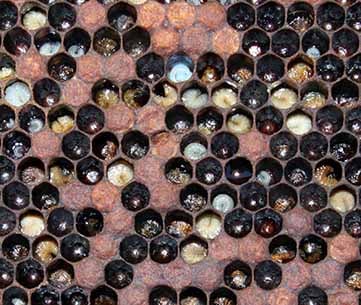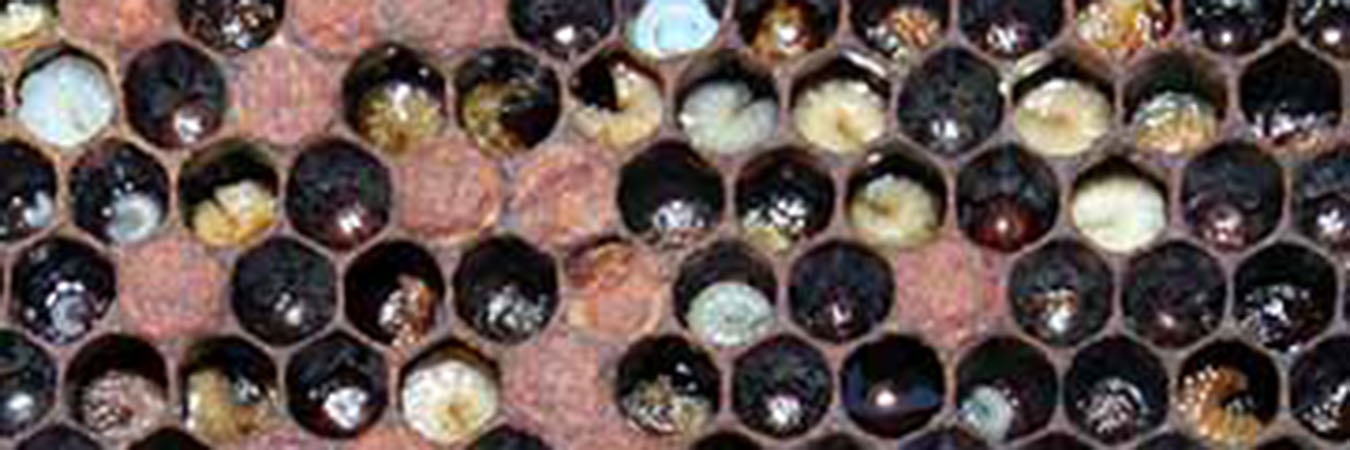European foulbrood is a bacterial disease caused by Melissococcus plutonius. It is highly contagious. The brood are infected by food contaminated with the bacterium. The bacterium multiplies and causes damage in the midgut, resulting in the larvae starving to death.
All brood stages are susceptible to infection, but it is most common in larvae. The disease is associated with stress: cool wet weather, poor nutrition, pesticides, and moving colonies. The outer brood combs are more likely to be affected than inner brood combs. In severe cases, adult bees may also be affected. Those that survive to adulthood can appear normal or undersized.
The disease is most common in early spring and autumn. It can reduce the productivity of colonies and, if unmanaged, can result in their death.
The bacterium can be spread in pollen, honey, water, faeces, combs, hive tools, and other equipment.
Diagnosis
European foulbrood can be mistaken for American foulbrood and viral diseases. Accurate diagnosis can only be made with laboratory testing, as for American foulbrood. Please refer to the link for testing in your state (QLD, NSW, VIC, TAS, SA, WA).
Death of brood results in a patchy brood comb, with diseased, dead, and healthy brood cells intermingled.
Infected larvae have a yellow to yellowish brown, mottled appearance and are twisted in their cells. Larvae dry out after several weeks and form a brown scale in the cell. Unlike American foulbrood, this scale can usually be easily removed from the cell. Dead larvae have a watery or pasty consistency.
Infected pupae may have a similar appearance to those affected by American foulbrood. Cell cappings appear sunken and/or perforated. Dead pupae may have a ropy consistency.
Treatment

Brood infected with European Foulbrood
Rob Snyder www.beeinformed.org
The antibiotic oxytetracycline hydrochloride can be used to treat European foulbrood. Use of antibiotics in honey bees is tightly regulated. Please refer to the link for regulations in your state (QLD, NSW, VIC, TAS, SA).
Surplus honey should be removed before applying the antibiotic. Antibiotics must not be applied within 8 weeks of a honey extraction. This is to prevent contamination of honey with antibiotics.
If more than 10% of colonies in an apiary show signs of the disease then treatment should be considered for all colonies.
- plutonius can remain viable for 3 years in the vegetative cell state. This state is not susceptible to antibiotics.
Each hive of two-or-more boxes should be treated with 1g of oxytetracycline hydrochloride mixed with 100g of castor sugar, sprinkled over the top of brood-nest frames, not directly to the brood comb. Ensure that the antibiotic is not past its expiry date as it may not be effective.
Antibiotics CANNOT and MUST NOT be used to treat American foulbrood.
Prevention
Antibiotics can leave detectable residues in honey. As such, they should not be the frontline choice for management of EFB. Instead, there are a number of other measures that beekeepers can take to reduce disease incidence and severity.
- Requeen your colonies regularly
- Purchase queens from queen breeders that select for disease resistance
- Replace two or more frames from the brood nest each year
- Move bees at night with adequate ventilation
- Ensure good nutrition by moving bees to good resources or supplementary feeding
- Prevent robbing of infected hives
- Use a barrier management system to prevent spread of disease
- Do not feed contaminated pollen or honey
- Perform regular brood comb inspections
Videos
European Foulbrood, Crispin Boxhall
European and American Foulbrood in Honey Bee Colonies, Bee Health
Acknowledgements:
- D. Somerville (2012) European foulbrood and its control. Primefact 1000. NSW Department of Primary Industries
- This article was peer-reviewed by Tom Gillard and Michael Holmes


